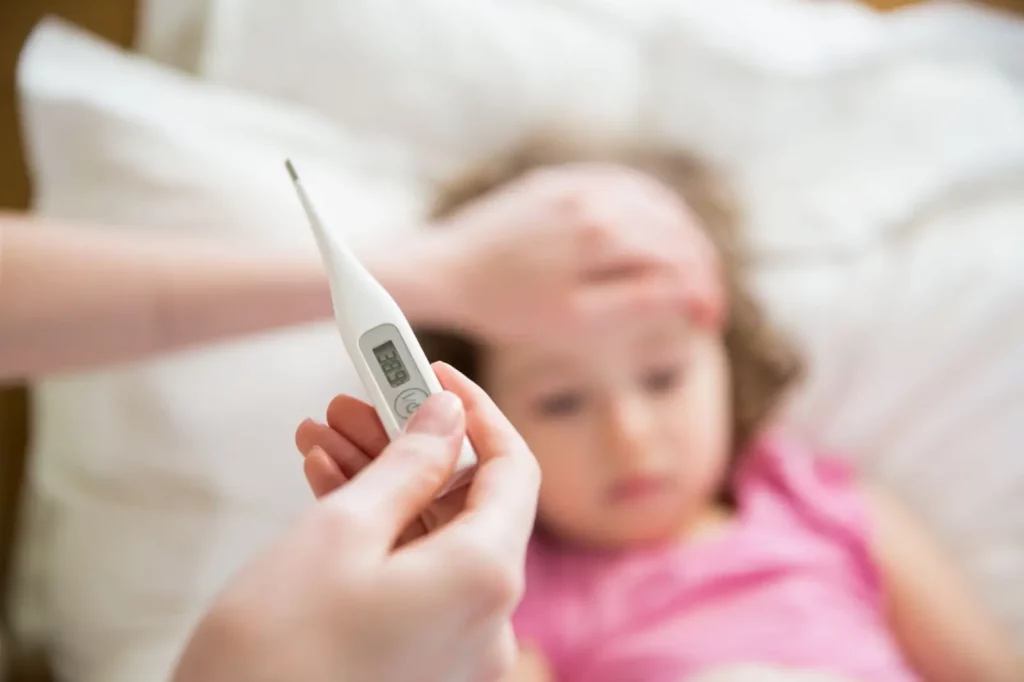Fever is a common symptom that can often be managed at home with rest and over-the-counter remedies.
However, discerning when is a fever an emergency is vital for timely medical intervention and appropriate treatment.
While fevers are typically the body’s natural response to infections, specific accompanying symptoms may signal a more serious underlying condition requiring immediate medical attention.
This article aims to clarify the signs and symptoms that indicate that seeking emergency care for a fever is necessary.
What Counts As A Fever?
A fever is generally defined as a temporary increase in body temperature above the normal range, which is around 98.6°F (37°C).
However, the threshold for what constitutes a fever can vary depending on factors such as age, underlying health conditions, and the method of temperature measurement.
Meanwhile, if you want to know when is a fever too high for adults, you need to check if the fever exceeds 100.4°f (38°c) when measured orally.
What Causes A Fever?

Fevers are typically the result of the body’s immune response to infection or illness.
Common causes include:
- Infections: These include viral or bacterial infections, ranging from the common cold to more serious conditions like pneumonia.
- Inflammatory disorders: Conditions such as rheumatoid arthritis or inflammatory bowel disease can trigger fevers.
- Heat exposure: Prolonged exposure to high temperatures or heatstroke can lead to fever.
- Medications: Certain drugs, including antibiotics and anticonvulsants, may cause fevers as a side effect.
Diagnosing The Cause Of A Fever
Diagnosing the cause of a fever often requires a comprehensive evaluation by a healthcare professional.
This process typically involves a thorough medical history review, physical examination, and possibly diagnostic tests such as blood tests, imaging studies, or cultures to identify the underlying infection or condition.
The specific approach to diagnosis may vary depending on factors such as the duration and severity of the fever, accompanying symptoms, and the individual’s medical history.
How Long Does A Fever Last?
The duration of a fever can vary widely depending on its underlying cause and individual factors.
In many cases, fevers caused by common viral infections may last for a few days to a week and typically resolve on their own without medical intervention. However, fevers associated with bacterial infections or other more severe conditions may persist for extended periods and require medical evaluation and treatment.
It’s important to monitor the duration and progression of a fever closely and seek medical attention if it persists for more than a few days, is accompanied by severe symptoms, or if there are concerns about its underlying cause
How High Is Too High For A Fever?

Determining when a fever becomes dangerously high depends on various factors, including age, overall health, and accompanying symptoms.
Generally, a temperature above 104°F (40°C) is considered very high and may indicate a severe medical condition, particularly in adults. For infants under three months old, any fever over 100.4°F (38°C) warrants immediate medical attention.
Additionally, individuals with compromised immune systems or chronic medical conditions should be vigilant, as lower temperatures may still pose significant risks.
It’s essential to seek medical assistance promptly if a fever reaches or exceeds these thresholds, especially if accompanied by symptoms like difficulty breathing, confusion, or persistent vomiting.
How To Treat A Fever At Home
When faced with a fever, it’s essential to know how to manage it safely and effectively at home. While fevers are often the body’s natural response to infection and can help fight off illness, discomfort and concerns may arise.
Here’s a guide to treating a fever at home:
- Stay hydrated: Drink plenty of fluids such as water, clear broths, and herbal teas to prevent dehydration and help regulate body temperature.
- Get adequate rest: Allow your body time to rest and recover by getting plenty of sleep and avoiding strenuous activities.
- Use over-the-counter medications: Over-the-counter fever reducers like acetaminophen (Tylenol) or ibuprofen (Advil, Motrin) can help reduce fever and alleviate discomfort. Follow the recommended dosage instructions carefully.
- Dress comfortably: Wear lightweight and breathable clothing to help regulate body temperature. Use lightweight blankets if feeling chilled.
- Take a lukewarm bath or sponge bath: Bathing in lukewarm water or using a sponge bath can help lower body temperature gently. Avoid cold water, which can cause shivering and raise body temperature.
When Should You Go To The ER For A Fever?
When a fever strikes, it’s important to know when it’s time to seek emergency medical care. While many fevers can be managed at home with rest and over-the-counter medications, certain situations warrant immediate attention from healthcare professionals.
Here’s when to consider heading to the emergency room based on age groups:
Infants (age 0-3 months)
For infants under three months old, any fever over 100.4°F (38°C) is considered a medical emergency.
Since infants’ immune systems are still developing, even a slight elevation in temperature can indicate a serious infection. Prompt medical evaluation is key to ruling out potentially life-threatening conditions.
Children
In children, or specifically fever that comes and goes in a toddler, accompanied by symptoms such as lethargy, difficulty breathing, severe headache, stiff neck, or dehydration may warrant a trip to the fever emergency room.
Additionally, if a fever persists for more than a few days despite home treatment or if there are concerns about the underlying cause, medical evaluation is recommended.
Adults
While most fevers in adults are not typically cause for immediate concern, there are certain circumstances where seeking emergency care is necessary.
Adults with fevers over 104°F (40°C) that are accompanied by severe symptoms such as confusion, difficulty breathing, chest pain, or persistent vomiting should go to the emergency room.
Individuals with compromised immune systems, chronic medical conditions, or recent travel to areas with infectious diseases should seek medical attention promptly if a fever develops.
How Is A Fever Treated In The ER?

When a fever becomes severe or is accompanied by concerning symptoms, seeking emergency medical care is crucial. In the emergency room (ER), healthcare professionals employ various strategies to address the underlying cause of the fever and alleviate associated symptoms.
Here’s an overview of how fevers are typically treated in the ER:
- Assessment and Diagnosis: Upon arrival at the ER, the medical team will conduct a thorough evaluation to determine the cause of the fever. This may include reviewing the patient’s medical history, performing a physical examination, and ordering diagnostic tests such as blood work, imaging studies, or cultures to identify the underlying infection or condition.
- Fever Reduction: To bring down a high fever quickly, healthcare providers may administer fever-reducing medications intravenously, such as acetaminophen (Tylenol) or ibuprofen (Advil). These medications can help lower body temperature and alleviate discomfort.
- Fluid Replacement: Fever can lead to dehydration, especially if accompanied by symptoms like sweating or vomiting. In the ER, patients may receive intravenous fluids to restore hydration levels and maintain electrolyte balance.
- Antibiotics or Antiviral Medications: If the fever is due to a bacterial or viral infection, the ER healthcare team may prescribe antibiotics or antiviral medications to treat the underlying cause directly.
- Monitoring and Observation: Patients with severe fevers or underlying medical conditions may require close monitoring in the ER if they show fever and fast heart rate. Vital signs, including temperature, heart rate, and respiratory rate, will be monitored regularly to assess the patient’s condition and response to treatment.
- Further Evaluation and Treatment: Depending on the underlying cause of the fever, additional interventions or treatments may be necessary. This could include procedures such as drainage of abscesses, surgical intervention for certain conditions, or referral to specialists for further management.
In the ER, prompt and comprehensive treatment of fever is essential to prevent complications and promote recovery. Healthcare providers work diligently to address the underlying cause of the fever while providing supportive care to manage symptoms and ensure the patient’s well-being.
Expert Care For Fevers In The Emergency Room
Fevers can range from mild to severe and may indicate underlying health concerns that require prompt attention. When facing a fever accompanied by concerning symptoms, seeking care at a 24-hour emergency room in Texas should be your priority.
Total Point ER, with multiple locations across Texas, is ready to provide expert medical attention and compassionate care around the clock if your high fever won’t go down.
Our experienced healthcare team is equipped to assess, diagnose, and treat fevers effectively, ensuring that patients receive the timely intervention they need for optimal recovery. We are also ready to assist you with your insurance and billing concerns.
Don’t hesitate to seek emergency medical care for fevers and associated symptoms. Visit Total Point ER, conveniently located across Texas, for expert evaluation and treatment.

